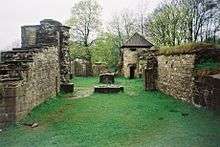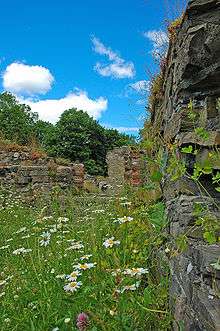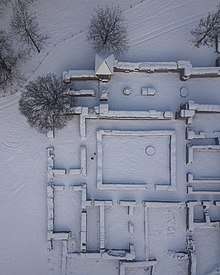Hovedøya Abbey
Hovedøya Abbey (Hovedøya kloster) was a medieval era Cistercian monastery on the island of Hovedøya in Oslofjord outside of Oslo, Norway. [1]



History
The monastery was founded on 18 May 1147 by monks from Kirkstead Abbey in England on Hovedøya island, and dedicated to the Blessed Virgin Mary and Saint Edmund. A church dedicated to Edmund already stood on the island, and the monks took this over as the abbey church, modifying it to meet Cistercian requirements. The rest of the monastery follow a modified Cistercian building plan, to take into account a small local hill. The church itself is built in Romanesque style; the rest of the monastery was presumably Gothic. During the medieval period the abbey was one of the richest institutions in Norway, holding over 400 properties, including a fishery and timber yards.[2] [3]
End of the abbey
Political turmoil during the succession to the throne of Denmark-Norway led to the end of the monastery. The abbot, having supported the Protestant King Christian II, possibly in a bid to gain support in the face of the coming Reformation, came into conflict with the commandant of Akershus Fortress, Mogens Gyldenstierne (ca. 1485–1569), who ironically had supported the Roman Catholic Prince Frederick I. In 1532 the abbot was thrown into prison for his political involvements, and the abbey was looted and then set ablaze, thus ending 400 years of monastic activity at Hovedøya. Any hope the order might have had in restoring the rich abbey was dashed 4 years later, when the Reformation swept over Denmark-Norway. [4]
The site was later used as a quarry for stone for Akershus Fortress. The remaining ruins are nevertheless among the most complete of a medieval Norwegian monastery. Between the years 1930–193, architect Gerhard Fischer performed excavations on site.
References
- "Hovedøya kloster". lokalhistoriewiki. Retrieved September 1, 2018.
- "Hovedøya kloster i Oslo". Norges klostre i middelalderen. Retrieved September 1, 2018.
- "Hovedøya kloster". Kulturminnesok. Retrieved September 1, 2018.
- "Gyldenstjerne, Mogens, 1485-1569, Rigsraad". Dansk biografisk Lexikon. Retrieved September 1, 2018.
Other Sources
- Fischer, Gerhard (1974) Klosteret på Hovedøya : et Cistercienseranlegg (Oslo:Fortidsminneforeningen) ISBN 8290052049
External links
- Ruins of Hovedøya www.visitoslo.com (in English)